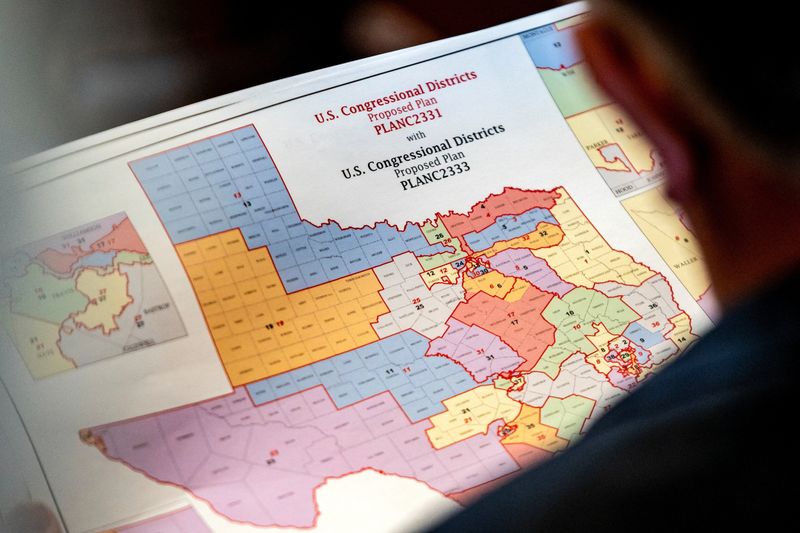
By Joseph Ax, Brad Brooks and Steve Gorman
(Reuters) -Texas lawmakers on Wednesday passed a new congressional district map intended to flip five Democratic-held U.S. House seats to Republican control in next year's midterm elections, a key step in an increasingly acrimonious partisan battle as California Democrats lined up their own redistricting effort.
Texas Republicans undertook the rare mid-decade redistricting at the behest of President Donald Trump, who says he wants to bolster the odds of preserving his party's slim majority in the U.S. House of Representatives amid political headwinds.
Democrats have accused Trump and the Republicans of a bid to unfairly rig the outcome of the 2026 midterm races.
Texas Republicans were able to proceed after dozens of Democratic lawmakers on Monday ended a two-week walkout from the statehouse in Austin that had deprived the House of the quorum needed to hold a vote.
The bill to redraw the map passed by a 88-52 vote along party lines. Once the Texas House and Senate have agreed on a version it will go to Governor Greg Abbott, a Republican, who has said he will sign it.
House debate in Texas came on the eve of floor action expected in California's state Senate for a redistricting package championed by Democratic Governor Gavin Newsom to redraw his state's congressional map to flip five Republican seats into the Democratic column.
Newsom and his Democratic allies in the state legislature are aiming to achieve fast-track passage of their newly drawn map by Friday, in time to place it on the ballot for voters in a special election aimed for November 4.
Democratic-controlled California is the nation's most populous state while Republican-led Texas ranks No. 2. Their clash over political boundaries may be just the beginning.
Other Republican states -- including Ohio, Florida, Indiana and Missouri -- are moving forward with or considering their own redistricting efforts, as are Democratic states such as Maryland and Illinois.
The Texas map would shift conservative voters into districts currently held by Democrats and combine some districts that Democrats hold.
PARTY POWER VS DISCRIMINATION
Republicans, including Trump, have openly acknowledged that the new map is aimed at increasing their political power. The party currently controls 25 of the state's 38 districts under a Republican-drawn map that was passed four years ago.
Democrats and civil rights groups have said the new map further dilutes the voting power of racial minorities in violation of federal law and have vowed to sue.
Redistricting typically occurs every 10 years after the U.S. Census to account for population changes. Mid-decade redistricting has historically been unusual. In many states, both Democratic and Republican lawmakers manipulate the lines to favor their party over the opposition, a practice known as gerrymandering.
Redrawing lines strictly for the purpose of favoring one party over the other has been generally accepted by the U.S. Supreme Court, while redrawing political lines on the basis of racial or ethnic discrimination is a violation of the federal Voting Rights Act.
Texas Democrats on Wednesday raised multiple objections to the redistricting measure before the final vote.
Democratic Representative John Bucy said from the House floor that the new maps were clearly intended to dilute the voting power of Black, Latino and Asian voters, and that his Republican colleagues' bending to the will of Trump was deeply worrying.
"This is not democracy, this is authoritarianism in real time," Bucy said. "This is Donald Trump's map. It clearly and deliberately manufactures five more Republican seats in Congress because Trump himself knows the voters are rejecting his agenda."
Republicans argued the map was created to improve political performance and would increase majority Hispanic districts.
Bucy was among the Democrats who fled the state to deny the Texas House a quorum.
In ending their walkout and voluntarily returning on Monday, Democrats said they had accomplished their goals of blocking a vote during a first special legislative session and persuading Democrats in other states to take retaliatory steps.
Nationally, Republicans captured control of the 435-seat U.S. House in 2024 by only three seats. The party of the president historically loses House seats in the first midterm election, and Trump's approval ratings have sagged since he took office in January.
(Reporting by Joseph Ax, Brad Brooks and Steve Gorman; Editing by Donna Bryson, Daniel Wallis and Leslie Adler)

 Reuters US Domestic
Reuters US Domestic
 CNN Politics
CNN Politics The Babylon Bee
The Babylon Bee The List
The List CNN
CNN Daily Kos
Daily Kos The Atlanta Journal-Constitution Sports
The Atlanta Journal-Constitution Sports NBC10 Philadelphia Entertainment
NBC10 Philadelphia Entertainment